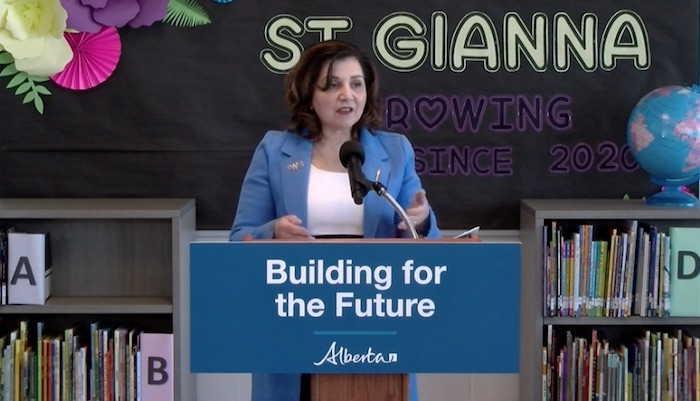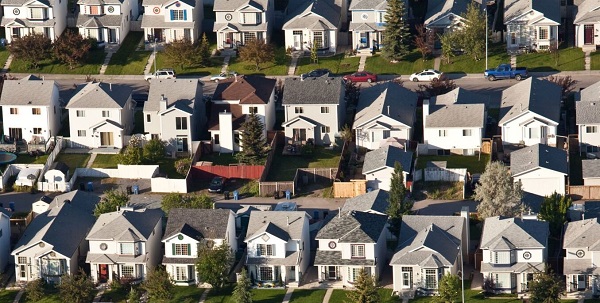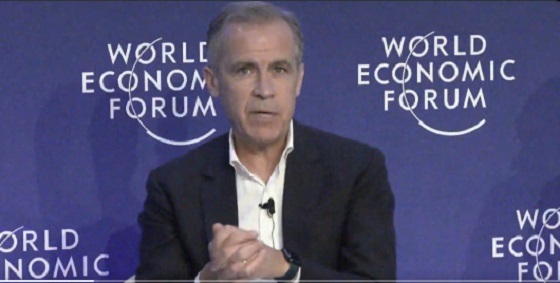Alberta
Education Minister Adriana LaGrange announces nearly 25,000 new and upgraded spaces for Alberta students

Investing in new schools, modernized spaces
Alberta’s government is investing $2.3 billion over the next three years, for new and modernized classrooms.
Budget 2023 supports 58 projects, which includes 13 full construction projects, 20 design, 14 planning and 11 pre-planning projects. In total, there will be nearly 25,000 new and additional spaces for students across Alberta – 9,400 new spaces and more than 15,500 student upgraded spaces. This includes approximately 4,500 new and upgraded spaces in Calgary, 4,100 in Edmonton and 16,300 for the rest of the province.
“Alberta’s young learners are the community and business leaders of tomorrow. They need the right spaces to gain the tools and skills needed to prepare for their bright futures. By investing in our schools, we’re investing in our students while at the same time creating more jobs and supporting the local economy.”
This investment in education infrastructure includes:
- $372 million for construction and design projects:
- 10 new schools
- 16 replacement schools
- seven modernizations
- $4 million to support planning activities such as site analysis and scope development for 14 projects
- $1 million to pre-plan 11 conceptual projects that are anticipated to become high-priority needs for school jurisdictions
- $1 billion to continue work on previously announced projects
- $300 million over three years in school authority self-directed capital projects
- $279 million to support the maintenance and renewal of existing school buildings through the Capital Maintenance and Renewal Program
- $171 million to support public charter school infrastructure, including investment for a charter hub in Calgary
- $43 million to fund facility upgrades for successful collegiate school applicants
- $93 million for the modular classroom program to address urgent space needs across the province
“The Alberta government is investing in critical infrastructure projects that include upgrading and building high-quality schools to ensure Albertans can send their children to schools in their local communities. Our focus is on ensuring these projects are delivered on time, on budget and where they’re needed.”
The availability of suitable sites has been one of the biggest roadblocks causing delays to school projects. That’s why, through Budget 2023, Alberta’s government is creating a new School Planning Program that will serve as a transparent “pipeline” for upcoming school projects to begin as soon as formal construction funding is approved. Fourteen school projects will begin planning and site development through this new program while a further 11 projects will receive pre-planning funding to assist with developing scope options.
The planning program will allow for the further development of project scope and site investigation work. It will also help to clarify potential risks and identify mitigating strategies and costs. The goal is to provide school boards with the resources they need to remove barriers and better position the project for design consideration and construction approval in future budget cycles, which is expected to reduce costs and minimize schedule disruptions and delays.
“The Calgary Catholic Board of Trustees is grateful for the capital projects announced for the Calgary Catholic School District, which includes full funding for the K-9 school in Nolan Hill to serve this rapidly growing community. We anticipate receiving the full construction funding for the Rangeview high school and Chestermere K-9 school as soon as possible, after the design process is completed. These projects need urgent attention given the critical need for school infrastructure and CCSD’s high utilization rate in these communities. CCSD appreciates the pre-planning commitment towards the construction of the K-9 school in Redstone, the addition/enhancement of Bishop McNally High School and the construction of a new west-end high school.”
“On behalf of CBE students and their families, we thank the Government of Alberta for the capital plan announcement. These extraordinary and timely investments in infrastructure are vital to support student learning opportunities within our system.”
“This is an exciting day for Elk Island Public Schools, for the community and especially for students of both École Campbelltown and Sherwood Heights Junior High. A modern, well-equipped and efficient building will allow us to continue to offer the quality education students need to succeed in the classroom and will help ease the growth pressures we are facing in Sherwood Park.”
Quick facts:
- Full construction funding activities include construction and post-occupancy review.
- Design funding activities include the preparation of construction tender documents such as drawings and specifications.
- Planning funding activities include site analysis and scope development activities.
- Pre-planning funding allows a conceptual project to define scope elements, programming priorities and includes activities such as community engagement.
- To support the decision-making process for delivering infrastructure projects, the Ministry of Infrastructure passed the Infrastructure Accountability Act in December 2021. This act outlines how the province prioritizes projects for the annual capital plan.
- As legislated by the act, the government also published Building Forward: Alberta’s 20-Year Strategic Capital Plan in December 2021, providing a blueprint for long-term infrastructure investment and development in Alberta.
- The government’s budget decisions are made in accordance with the act and are guided by the strategic capital plan to ensure future capital investments benefit Albertans.
- Government partners, such as municipalities and school boards, will also be able to plan for capital funding knowing the long-term direction of government.
Budget 2023 school projects – full construction funding (13):
| Community | School division | Project type/Name |
| Airdrie | Conseil scolaire FrancoSud | new secondary school |
| Calgary | Calgary Board of Education | modernization of John G. Diefenbaker High School |
| Calgary | Calgary Roman Catholic Separate School Division | new K-9 school in Nolan Hill |
| Edmonton | Conseil scolaire Centre-Nord | solution for École Michaëlle-Jean and École Gabrielle-Roy |
| Edmonton | Edmonton Public School Board | new K-9 school in Edgemont |
| Lethbridge | Holy Spirit Roman Catholic Separate School Division | new K-6 school in west Lethbridge |
| Lethbridge | Conseil scolaire FrancoSud | École La Vérendrye gym project |
| Okotoks | Christ the Redeemer Catholic Separate School Division | replacement of École Good Shepherd School |
| Penhold | Chinook’s Edge School Division | replacement of Penhold Elementary School |
| Raymond | Westwind School Division | new high school |
| Sherwood Park | Elk Island School Division | solution for Sherwood Park |
| Valleyview | Northern Gateway School Division | solution for Valleyview |
| Waskatenau | Lakeland Roman Catholic Separate School Division | replacement of Holy Family Catholic School |
Budget 2023 school projects – design funding (20):
| Community | School division | Project type/Name |
| Airdrie | Rocky View School Division | new K-8 school in southwest Airdrie |
| Barrhead | Pembina Hills School Division | modernization and rightsizing of Barrhead Composite High School |
| Blackfalds | Red Deer Catholic Separate School Division | new K-5 school |
| Bow Island / Burdett | Prairie Rose School Division | solution for Bow Island and Burdett |
| Breton | Wild Rose School Division | modernization and rightsizing of Breton High School and demolition of Breton Elementary School |
| Brooks | Grasslands School Division | replacement of Brooks Junior High School |
| Chestermere | Calgary Roman Catholic Separate School Division | new K-9 school |
| Calgary | Calgary Roman Catholic Separate School Division | new high school in Rangeview |
| Edmonton | Edmonton Catholic Separate School Division | solution for Rundle Heights |
| Edmonton | Edmonton Public School Board | new junior/senior high school in Glenridding Heights |
| Fort McMurray | Conseil scolaire Centre-Nord | replacement of K-12 École Boréale |
| Lac La Biche | Northern Lights School Division | replacement of Vera M. Welsh School |
| Leduc | Black Gold School Division | modernization of École Corinthia Park School |
| Mallaig | St. Paul School Division | replacement of École Mallaig School |
| Medicine Hat | Medicine Hat Roman Catholic Separate School Division | replacement of St. Francis Xavier School |
| Nanton | Livingstone Range School Division | solution for Nanton |
| Red Earth Creek | Peace River School Division | replacement of Red Earth Creek School |
| Spruce Grove | Parkland School Division | replacement of Spruce Grove Composite High School |
| Taber | Horizon School Division | modernization of the W.R. Myers and D.A. Ferguson schools |
| Wainwright | Buffalo Trail School Division | replacement of Wainwright School |
Budget 2023 – School Planning Program projects (14):
| Community | School division | Project type/Name |
| Airdrie | Rocky View School Division | new grades 9-12 school |
| Calgary | Calgary Board of Education | modernization of Annie Gale School |
| Calgary | Calgary Board of Education | new high school in Cornerstone |
| Coalhurst | Palliser School Division | modernization of Coalhurst High School |
| Donnelly | High Prairie School Division | G. P. Vanier School |
| Edmonton | Edmonton Catholic Separate School Division | new K-9 school in Heritage Valley Cavanagh |
| Edmonton | Edmonton Public School Board | new K-6 school in Rosenthal |
| Edmonton | Edmonton Public School Board | new elementary school in Glenridding Heights |
| Fort McMurray | Fort McMurray School Division | modernization of Westwood Community High School |
| Grande Prairie | Peace Wapiti School Division | new high school north of Grande Prairie |
| Lethbridge | Lethbridge School Division | modernization of Galbraith Elementary School |
| Okotoks | Foothills School Division | new high school |
| Stettler | Clearview School Division | modernization and addition at Stettler Middle School |
| Strathmore | Golden Hills School Division | replacement of Westmount School |
Budget 2023 – Pre-Planning Program projects (11):
| Community | School division | Project type/Name |
| Calgary | Calgary Board of Education | modernization of A.E. Cross School |
| Calgary | Calgary Board of Education | modernization of Sir John A. Macdonald School |
| Calgary | Calgary Board of Education | new Saddle Ridge middle school |
| Calgary | Calgary Roman Catholic Separate School Division | new elementary school in Redstone |
| Calgary | Calgary Roman Catholic Separate School Division | addition at Bishop McNally High School |
| Calgary | Calgary Roman Catholic Separate School Division | new west Calgary high school |
| Chestermere | Rocky View School Division | new K-9 school |
| Cochrane | Rocky View School Division | new K-5/K-8 |
| Edmonton | Edmonton Catholic Separate School Division | new north K-9 school |
| Edmonton | Edmonton Public School Division | new junior high school in Pilot Sound/McConachie |
| Red Deer | Red Deer Public Schools | new northeast middle school |
Alberta
Calgary’s High Property Taxes Run Counter to the ‘Alberta Advantage’

By David Hunt and Jeff Park
Of major cities, none compare to Calgary’s nearly 50 percent property tax burden increase between censuses.
Alberta once again leads the country in taking in more new residents than it loses to other provinces and territories. But if Canadians move to Calgary seeking greater affordability, are they in for a nasty surprise?
In light of declining home values and falling household incomes amidst rising property taxes, Calgary’s overall property tax burden has skyrocketed 47 percent between the last two national censuses, according to a new study by the Aristotle Foundation for Public Policy.
Between 2016 and 2021 (the latest year of available data), Calgary’s property tax burden increased about twice as fast as second-place Saskatoon and three-and-a-half times faster than Vancouver.
The average Calgary homeowner paid $3,496 in property taxes at the last census, compared to $2,736 five years prior (using constant 2020 dollars; i.e., adjusting for inflation). By contrast, the average Edmonton homeowner paid $2,600 in 2021 compared to $2,384 in 2016 (in constant dollars). In other words, Calgary’s annual property tax bill rose three-and-a-half times more than Edmonton’s.
This is because Edmonton’s effective property tax rate remained relatively flat, while Calgary’s rose steeply. The effective rate is property tax as a share of the market value of a home. For Edmontonians, it rose from 0.56 percent to 0.62 percent—after rounding, a steady 0.6 percent across the two most recent censuses. For Calgarians? Falling home prices collided with rising taxes so that property taxes as a share of (market) home value rose from below 0.5 percent to nearly 0.7 percent.
Plug into the equation sliding household incomes, and we see that Calgary’s property tax burden ballooned nearly 50 percent between censuses.
This matters for at least three reasons. First, property tax is an essential source of revenue for municipalities across Canada. City councils set their property tax rate and the payments made by homeowners are the backbone of municipal finances.
Property taxes are also an essential source of revenue for schools. The province has historically required municipalities to directly transfer 33 percent of the total education budget via property taxes, but in the period under consideration that proportion fell (ultimately, to 28 percent).
Second, a home purchase is the largest expense most Canadians will ever make. Local taxes play a major role in how affordable life is from one city to another. When municipalities unexpectedly raise property taxes, it can push homeownership out of reach for many families. Thus, homeoowners (or prospective homeowners) naturally consider property tax rates and other local costs when choosing where to live and what home to buy.
And third, municipalities can fall into a vicious spiral if they’re not careful. When incomes decline and residential property values fall, as Calgary experienced during the period we studied, municipalities must either trim their budgets or increase property taxes. For many governments, it’s easier to raise taxes than cut spending.
But rising property tax burdens could lead to the city becoming a less desirable place to live. This could mean weaker residential property values, weaker population growth, and weaker growth in the number of residential properties. The municipality then again faces the choice of trimming budgets or raising taxes. And on and on it goes.
Cities fall into these downward spirals because they fall victim to a central planner’s bias. While $853 million for a new arena for the Calgary Flames or $11 million for Calgary Economic Development—how City Hall prefers to attract new business to Calgary—invite ribbon-cuttings, it’s the decisions about Calgary’s half a million private dwellings that really drive the city’s finances.
Yet, a virtuous spiral remains in reach. Municipalities tend to see the advantage of “affordable housing” when it’s centrally planned and taxpayer-funded but miss the easiest way to generate more affordable housing: simply charge city residents less—in taxes—for their housing.
When you reduce property taxes, you make housing more affordable to more people and make the city a more desirable place to live. This could mean stronger residential property values, stronger population growth, and stronger growth in the number of residential properties. Then, the municipality again faces a choice of making the city even more attractive by increasing services or further cutting taxes. And on and on it goes.
The economy is not a series of levers in the mayor’s office; it’s all of the million individual decisions that all of us, collectively, make. Calgary city council should reduce property taxes and leave more money for people to make the big decisions in life.
Jeff Park is a visiting fellow with the Aristotle Foundation for Public Policy and father of four who left Calgary for better affordability. David Hunt is the research director at the Calgary-based Aristotle Foundation for Public Policy. They are co-authors of the new study, Taxing our way to unaffordable housing: A brief comparison of municipal property taxes.
Alberta
Petition threatens independent school funding in Alberta

From the Fraser Institute
Recently, amid the backdrop of a teacher strike, an Alberta high school teacher began collecting signatures for a petition to end government funding of independent schools in the province. If she gets enough people to sign—10 per cent of the number of Albertans who voted in the last provincial election—Elections Alberta will consider launching a referendum about the issue.
In other words, the critical funding many Alberta families rely on for their children’s educational needs may be in jeopardy.
In Alberta, the provincial government partially funds independent schools and charter schools. The Alberta Teachers’ Association (ATA), whose members are currently on strike, opposes government funding of independent and charter schools.
But kids are not one-size-fits-all, and schools should reflect that reality, particularly in light of today’s increasing classroom complexity where different kids have different needs. Unlike government-run public schools, independent schools and charter schools have the flexibility to innovate and find creative ways to help students thrive.
And things aren’t going very well for all kids or teachers in government-run pubic school classrooms. According to the ATA, 93 per cent of teachers report encountering some form of aggression or violence at school, most often from students. Additionally, 85 per cent of unionized teachers face an increase in cognitive, social/emotional and behavioural issues in their classrooms. In 2020, one-quarter of students in Edmonton’s government-run public schools were just learning English, and immigration to Canada—and Alberta especially—has exploded since then. It’s not easy to teach a classroom of kids where a significant proportion do not speak English, many have learning disabilities or exceptional needs, and a few have severe behavioural problems.
Not surprisingly, demand for independent schools in Alberta is growing because many of these schools are designed for students with special needs, Autism, severe learning disabilities and ADHD. Some independent schools cater to students just learning English while others offer cultural focuses, expanded outdoor time, gifted learning and much more.
Which takes us back to the new petition—yet the latest attempt to defund independent schools in Alberta.
Wealthy families will always have school choice. But if the Alberta government wants low-income and middle-class kids to have the ability to access schools that fit them, too, it’s crucial to maintain—or better yet, increase—its support for independent and charter schools.
Consider a fictional Alberta family: the Millers. Their daughter, Lucy, is struggling at her local government-run public school. Her reading is below grade level and she’s being bullied. It’s affecting her self-esteem, her sleep and her overall wellbeing. The Millers pay their taxes. They don’t take vacations, they rent, and they haven’t upgraded their cars in many years. They can’t afford to pay full tuition for Lucy to attend an independent school that offers the approach to education she needs to succeed. However, because the Alberta government partially funds independent schools—which essentially means a portion of the Miller family’s tax dollars follow Lucy to the school of their choice—they’re able to afford the tuition.
The familiar refrain from opponents is that taxpayers shouldn’t pay for independent school tuition. But in fact, if you’re concerned about taxpayers, you should encourage school choice. If Lucy attends a government-run public school, taxpayers pay 100 per cent of her education costs. But if she attends an independent or charter school, taxpayers only pay a portion of the costs while her parents pay the rest. That’s why research shows that school choice saves tax dollars.
If you’re a parent with a child in a government-run public school in Alberta, you now must deal with another teacher strike. If you have a child in an independent or charter school, however, it’s business as usual. If Albertans are ever asked to vote on whether or not to end government funding for independent schools, they should remember that students are the most important stakeholder in education. And providing parents more choices in education is the solution, not the problem.
-

 Health2 days ago
Health2 days agoNew report warns WHO health rules erode Canada’s democracy and Charter rights
-

 Courageous Discourse1 day ago
Courageous Discourse1 day agoNo Exit Wound – EITHER there was a very public “miracle” OR Charlie Kirk’s murder is not as it appears
-

 Business1 day ago
Business1 day agoEmission regulations harm Canadians in exchange for no environmental benefit
-

 Business1 day ago
Business1 day agoQuebecers want feds to focus on illegal gun smuggling not gun confiscation
-

 Alberta1 day ago
Alberta1 day agoPetition threatens independent school funding in Alberta
-

 Energy2 days ago
Energy2 days agoMinus Forty and the Myth of Easy Energy
-

 National1 day ago
National1 day agoPolitically Connected Canadian Weed Sellers Push Back in B.C. Court, Seek Distance from Convicted Heroin Trafficker
-

 Business23 hours ago
Business23 hours agoCanada Revenue Agency found a way to hit “Worse Than Rock Bottom”







